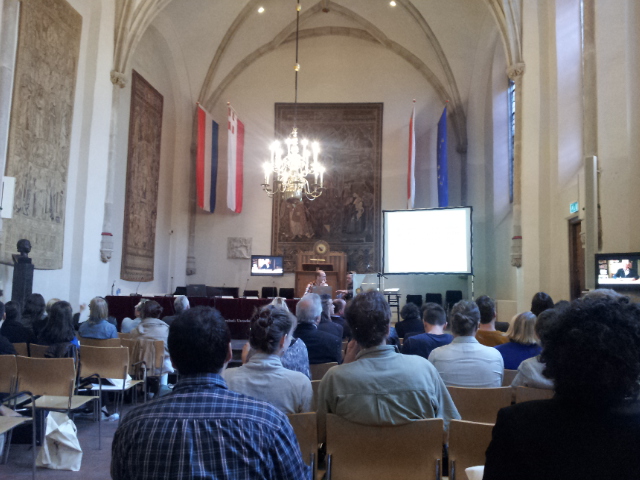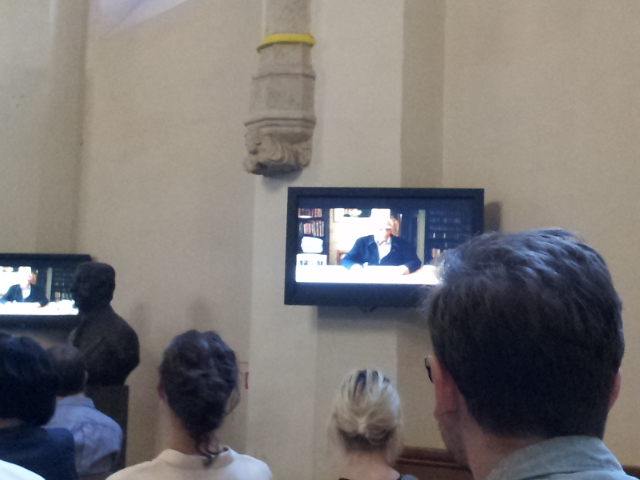There was a great sadness this morning at the conference that Michel Serres’ health has not permitted him to travel to Utrecht in person, but also a deep thankfulness and appreciation that, despite his failing health, he had taken the time to pre-record his address. The discussion that followed his paper (recorded at his house in Vincennes and played to the conference on a series of television screens around the meeting room in St Martin’s Cathedral, pictured below) certainly lacked for nothing in terms of liveliness.
Serres delivered his address in French, and English translation (entitled ‘Information and Thinking’) was handed round to the delegates.
In the address Serres elaborates upon a theme that punctuates his work from the Hermes series onward: information. It strikes me that Serres’ notion of information and communication circulating between all entities (human, animal, vegetable and mineral) could be interestingly and profitably compared with Jean-Luc Nancy’s notion of ‘renvois de sens’ in L’Adoration. In particular, I wonder whether Serres could (or would want to) include within the ambit of communicative circulation not only all physical entities but also ideas as well, as Nancy does in some of his characteristic lists un/closed with aposiopeses.
In the video address, Serres quoted at length from Jules Verne’s The Star of the South, a passage describing the glittering luminescence of a cave studded with precious stones (I reproduce the quotation in full at the foot of this post, from the Internet Archive version)[1]. The proliferation of precious stones in the Verne passage dovetails nicely of course with Serres’ insistence, in La Distribution (p271) and elsewhere, that nothing distinguishes me, ontologically, from a crystal, since we are both receive, store, process and emit information.
Plato’s sun and Verne’s cave
There was some discussion after the paper about the contrast between the light in Verne’s cave and Plato’s parable of the cave in Republic VII: for Plato the prisoners must leave the cave/the material earth to find the light of the Eidos, whereas for Verne the light is in the cave. Françoise Balibar voiced some concern, if I understood her intervention correctly, about the politics of the Verne passage (the white explorers liberating the black man from the prison of the cave), but there was one crucial reference that, to my eyes at least, was overlooked in the discussion after the paper, and that provides an important context for Serres’ remarks about light and truth. Two paragraphs after the extended Verne quotation, Serres says the following:
“Philosophy loves light, and has turned it into a model of excellent knowledge, especially the splash of daytime sunshine. Sparkling with truth, light is supposed to chase away the darkness of obscurantism. That is an absurd and rather counter-intuitive idea, as we all know that any candle, as weakly as it may shine, immediately pushes back the shadow of the night, while no one has ever seen darkness overcome any source of light.” (CW’s emphasis)
Serres concludes the thought by saying ‘no to the tyranny’ of ‘one unique and totalitarian truth’, the sun in the sky of the Platonic topos ouranios. It seems to me that the latent dialogue partner at this point in Serres’ paper—the interlocutor in the shadows, we might say—is the writer of the fourth gospel, and specifically the first seventeen verses, usually known as the prologue:
1 In the beginning was the Word, and the Word was with God, and the Word was God.
2 He was in the beginning with God.
3 All things were made through him,
and without him was not any thing made that was made.
4 In him was life, and the life was the light of men.
5 The light shines in the darkness, and the darkness has not overcome it.
6 There was a man sent from God, whose name was John.
7 He came as a witness, to bear witness about the light, that all might believe through him.
8 He was not the light, but came to bear witness about the light.
9 The true light, which gives light to everyone, was coming into the world.
10 He was in the world, and the world was made through him,
yet the world did not know him.
11 He came to his own, and his own people did not receive him.
12 But to all who did receive him, who believed in his name,
he gave the right to become children of God,
13 who were born, not of blood nor of the will of the flesh nor of the will of man,
but of God.
14 And the Word became flesh and dwelt among us,
and we have seen his glory,
glory as of the only Son from the Father, full of grace and truth.
15 (John bore witness about him, and cried out,
“This was he of whom I said,
‘He who comes after me ranks before me, because he was before me.'”)
16 For from his fullness we have all received, grace upon grace.
17 For the law was given through Moses; grace and truth came through Jesus Christ.
Preliminary note on translation
The Greek translated as ‘overcome’ in verse 5 (‘and the darkness has not overcome it’), the verb katalambano, has a semantic range covering ‘take’, ‘seize’, ‘possess’ and ‘apprehend’, (the KJV renders the verse ‘And the light shineth in darkness; and the darkness comprehended it not ’). So when Serres says that ‘no-one has ever seen darkness overcome any source of light’, we might also note that there are plenty of examples of ‘darkness’ failing to apprehend or grasp ‘light’. In the context of verses 10 and 11–‘yet the world did not know him’, ‘He came to his own, and his own people did not receive him’–a case could be made that the translation of the katelaben of verse 5 as ‘grasped’ or ‘understood’ cuts more with the grain of the ideas in the surrounding verses than does translating it as ‘overcome’.
1) The Johannine counterpoint to Republic VII
First, reading Serres’ comments as a latent reference to John’s prologue makes a lot of sense in the context of his quotation from Verne, because in both the Verne passage and the Johannine prologue the light sparkles in the midst of the darkness, not at a solar remove from it. As I argued in From Plato to Postmodernism, the Johannine prologue provides an ‘illuminating’ counterpoint to Republic VII in that the direction of travel is reversed: Plato’s prisoner must leave the darkness and ascend to the light, whereas for John ‘the word became flesh’ and the light descends to ‘shines in the darkness’.
2) The Johannine alternative to totalitarian lumophilia
In addition, John’s détournement of the Greek (Heraclitean, Stoic) logos into the ‘Word’ of the prologue gestures towards a response to Serres’ fears of totalitarianism. In contradistinction to Plato’s eternal, unchanging and ultimately inhuman, unique Sun (the Form of the Good), and in contradistinction to both the Heraclitean and Stoic impersonal logos-principles, John re-writes the logos as a person whose personhood is irreducible to more simple or more fundamental (and inhuman or non-human/infra-human) parts, and he rewrites Truth-as-Form and Truth-As-Law as Truth-as-Divine-Character. This personalisation (not personification, for as Nancy points out in Verbum caro factum, the word BECAME flesh: logos sarx egeneto) of the logos imbues it with all the subtlety, suppleness, wisdom, ipse-identity and dynamic faithfulness of a human character, a character furthermore in which truth/faithfulness can never legitimately be parsed from grace/love, as the prologue repeatedly insists: “glory as of the only Son from the Father, full of grace and truth” “For the law was given through Moses; grace and truth came through Jesus Christ.” (John 1: 14, 17). It is the Johannine distinctive that the arche, the beginning or source of all things, the logos, is an inextricable and irreducible marriage of grace and truth in the dynamism of a personal character that ‘shines in the darkness’, and furthermore it is that this personal, dynamic logos that offers an alternative to Serres’ reading of light-as-truth imagery as necessarily and monolithically ‘totalitarian’.
John does not offer us truth as the Sun, but truth in the Son, and the difference is irreducible.
Dazzled with the light after so long a darkness, Barthes and Cyprien thought at first they were the prey of some ecstatic illusion, so splendid and unexpected was the sight that greeted their eyes.
They were in the center of an immense grotto. The ground was covered with fine sand bespangled with gold. The vault was as high as that of a Gothic cathedral, and stretched away out of sight into the distant darkness. The walls were covered with stalactites of varied hue and wondrous richness, and from them the light of the torches as reflected, flashing back with all the colors of the rainbow, with the glow of a furnace fire and the wealth of the aurora.
Colors of the most dazzling, shapes the most extraordinary, dimensions the most unexpected, distinguished these innumerable crystals. They were not, as in most grottoes, pendants, monotonously similar to each other, but nature had given free scope to fancy, and seemed to have exhausted every combination of tint and effect to which the marvelous brilliancy of the rocks could lend itself.
Blocks of amethyst, walls of sardonyx, masses of rubies, needles of emeralds, colonnades of sapphires deep and slender as forest pines, bergs of aquamarine, whorls of turquoise, mirrors of opal, masses of rose gypsum, and gold-veined lapis lazuli all that the crystal kingdom could offer that was precious and rare and bright and dazzling had served as the materials for this astonishing specimen of architecture; and, further, every form, even of the vegetable kingdom, seemed to have been laid under contribution in the wondrous work. Carpets of mineral mosses soft and velvety as the finest gauze, crystalline trees loaded with flowers and fruits of jewels recalling the fairy gardens of Japanese art, lakes of diamonds, palaces of chalcedony, turrets and minarets of beryl and topaz, rose pile upon pile, and heaped together so many splendors that the eye refused to grasp them. The decomposition of the luminous rays by the thousands of prisms, the showers of brilliancy that flashed and flowed from every side, produced the most astonishing combination of light and color that had ever dazzled the eyes of man.
1 Comment
Comments are closed.


Reblogged this on Progressive Geographies and commented:
A report from Christopher Watkin on a paper from Michel Serres.